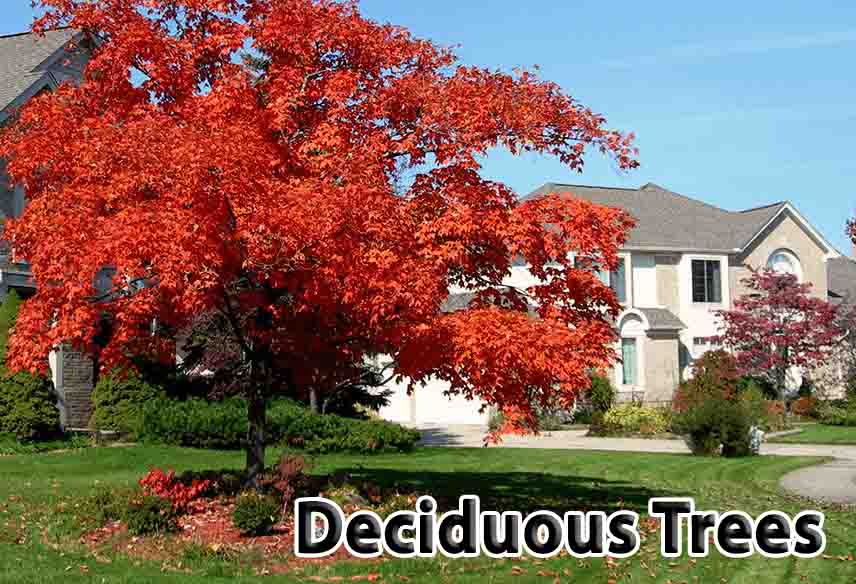Deciduous Trees Definition
Deciduous trees shed their leaves towards the conclusion of their growth season. This happens in the fall in temperate deciduous woods, and in the dry season in tropical and subtropical deciduous forests. The term deciduous originates from the Latin word decidere, meaning “to fall off.” The term for leaf loss is abscission.
These trees live in forests in the eastern United States, Canada, portions of Japan and China and much of Europe. Alternative names for deciduous trees include broadleaf trees or hardwood trees. Evergreens are trees that do not lose their leaves.
Types of Deciduous Trees
Some of the most well-known deciduous trees are:
- oak
- maple
- birch
- ash
- willow
- poplar
- aspen
- beech
- walnut
- …hundreds more
Examples of Deciduous Trees
Oak
There are roughly 450 species in the oak genus, Quercus, which comprises trees and shrubs. Among of the more common oak species include black, English, white, red and bur. Asian oak species include Mongolian, Oriental, Japanese, daimyo and sawtooth.
The broad flat leaves of the oak feature lobes with serrated edges in certain species. Acorns are the fruit of oak trees. Oak wood is extensively utilised as timber in the building, furniture and flooring sectors.
Maple
The maple genus, Acer, comprises roughly 200 species of trees and shrubs. Red, sugar and silver are some of the most prevalent kinds. Maples are commonly utilised as beautiful trees in landscaping and in locations where shade is required.
Specialty products that originate from maple trees include bowling pins, butcher blocks, baseball bats and maple syrup.
Samaras are the pairs of winged seeds on maples which fall with an unique propeller motion. Maples give some of the most spectacular fall leaf hues of any tree species.
Birch
Birch trees have smooth white and black bark and are utilised for lumber and decorative purposes. Of the approximately 40 species of the birch Betula genus, some of the most common are paper, river, grey, white and yellow. Two Japanese species are monarch and cherry birch. Birch leaves are egg-shaped or triangular and have serrated edges.
Birch leaves become yellow in September. Birch is often used to manufacture furniture, flooring, panelling, trim, cabinets and plywood. Native Indians and early immigrants in North America utilised birch bark for building boats, roofs and shoes.
How Deciduous Trees Lose Their Leaves
In fall, temperate deciduous trees enter a period of dormancy when all metabolic activities start to slow down, due mostly to the decreasing daylight hours. A substance called abscisic acid is created where the leaf and stem comes together. Abscisic acid causes the cells in that location to divide fast, but not expand.
This action has two effects: 1) the fast cell division causes the stem to separate from the branch and 2) the cells produce a cork-like coating that inhibits nutrients and minerals from accessing the leaf. Two plant hormones that also take role in abscission include auxin and ethylene.
Temperature, soil moisture and the quantity of sunlight impact the colours that develop in fall foliage before the leaves drop.
The leaves of tropical and subtropical deciduous trees fall as a mechanism to help the tree to preserve water in the dry season. Trees at these latitudes are not prone to considerably diminished daylight hours as temperate deciduous trees are.
Colors of Deciduous Tree Leaves in Autumn
Deciduous trees regularly renew chlorophyll throughout the warmer months. Chlorophyll is what gives plants their green hue, and it is used up during photosynthesis. For temperate deciduous trees, when temperatures drop and sunshine hours decrease in the fall, production of chlorophyll slows and finally stops.
For certain tree species, the removal of chlorophyll unveils other beautiful colours that were concealed in the leaves. The yellow, brown and orange colours often observed derive from more than 600 varieties of carotenoid pigments. Anthocyanin pigments result in red and purple, while tannins are brown.
Although carotenoid pigments are constantly present, the leaves generate anthocyanins in late summer, around the time abscission occurs. Several deciduous tree species shed their leaves without any visible colour change.

